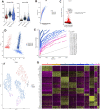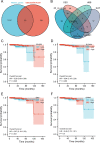Exploring the role of differentially expressed metabolic genes and their mechanisms in bone metastatic prostate cancer
- PMID: 37070095
- PMCID: PMC10105558
- DOI: 10.7717/peerj.15013
Exploring the role of differentially expressed metabolic genes and their mechanisms in bone metastatic prostate cancer
Abstract
Background: Approximately 10-20% of patients diagnosed with prostate cancer (PCa) evolve into castration-resistant prostate cancer (CRPC), while nearly 90% of patients with metastatic CRPC (mCRPC) exhibit osseous metastases (BM). These BM are intimately correlated with the stability of the tumour microenvironment.
Purpose: This study aspires to uncover the metabolism-related genes and the underlying mechanisms responsible for bone metastatic prostate cancer (BMPCa).
Methods: Gene Expression Omnibus (GEO) and The Cancer Genome Atlas (TCGA) datasets of PCa and BM were analyzed through R Studio software to identify differentially expressed genes (DEGs). The DEGs underwent functional enrichment via Kyoto Encyclopedia of Genes and Genomes (KEGG) and Gene Ontology (GO), with key factors screened by a random forest utilized to establish a prognostic model for PCa. The study explored the relationship between DEGs and the stability of the immune microenvironment. The action and specificity of CRISP3 in PCa was validated through western blot analysis, CCK-8 assay, scratch assay, and cellular assay.
Results: The screening of GEO and TCGA datasets resulted in the identification of 199 co-differential genes. Three DEGs, including DES, HBB, and SLPI, were selected by random forest classification model and cox regression model. Immuno-infiltration analysis disclosed that a higher infiltration of naïve B cells and resting CD4 memory T cells occurred in the high-expression group of DES, whereas infiltration of resting M1 macrophages and NK cells was greater in the low-expression group of DES. A significant infiltration of neutrophils was observed in the high-expression group of HBB, while greater infiltration of gamma delta T cells and M1 macrophages was noted in the low-expression group of HBB. Resting dendritic cells, CD8 T cells, and resting T regulatory cells (Tregs) infiltrated significantly in the high-expression group of SLPI, while only resting mast cells infiltrated significantly in the low-expression group of SLPI. CRISP3 was established as a critical gene in BMPCa linked to DES expression. Targeting CRISP3, d-glucopyranose may impact tumour prognosis. During the mechanistic experiments, it was established that CRISP3 can advance the proliferation and metastatic potential of PCa by advancing epithelial-to-mesenchymal transition (EMT).
Conclusion: By modulating lipid metabolism and maintaining immunological and microenvironmental balance, DES, HBB, and SLPI suppress prostate cancer cell growth. The presence of DES-associated CRISP3 is a harbinger of unfavorable outcomes in prostate cancer and may escalate tumor proliferation and metastatic capabilities by inducing epithelial-mesenchymal transition.
Keywords: Bone metastasis (BM); Epithelial to mesenchymal transition (EMT); Immuno-microenvironmental homeostasis; Prostate cancer (PCa); scRNA-seq.
©2023 Zhang et al.
Conflict of interest statement
The authors declare there are no competing interests.
Figures







Similar articles
-
Prognostic signatures associated with high infiltration of Tregs in bone metastatic prostate cancer.Aging (Albany NY). 2021 Jul 6;13(13):17442-17461. doi: 10.18632/aging.203234. Epub 2021 Jul 6. Aging (Albany NY). 2021. PMID: 34229299 Free PMC article.
-
Analysis of genomics and immune infiltration patterns of epithelial-mesenchymal transition related to metastatic breast cancer to bone.Transl Oncol. 2021 Feb;14(2):100993. doi: 10.1016/j.tranon.2020.100993. Epub 2020 Dec 14. Transl Oncol. 2021. PMID: 33333372 Free PMC article.
-
A novel tumor purity and immune infiltration-related model for predicting distant metastasis-free survival in prostate cancer.Eur J Med Res. 2023 Nov 28;28(1):545. doi: 10.1186/s40001-023-01522-8. Eur J Med Res. 2023. PMID: 38017548 Free PMC article.
-
Identify potential prognostic indicators and tumor-infiltrating immune cells in pancreatic adenocarcinoma.Biosci Rep. 2022 Feb 25;42(2):BSR20212523. doi: 10.1042/BSR20212523. Biosci Rep. 2022. PMID: 35083488 Free PMC article. Review.
-
Cellular determinants and microenvironmental regulation of prostate cancer metastasis.Semin Cancer Biol. 2017 Jun;44:83-97. doi: 10.1016/j.semcancer.2017.03.009. Epub 2017 Apr 11. Semin Cancer Biol. 2017. PMID: 28408152 Free PMC article. Review.
Cited by
-
CAP superfamily proteins in human: a new target for cancer therapy.Med Oncol. 2024 Nov 5;41(12):306. doi: 10.1007/s12032-024-02548-6. Med Oncol. 2024. PMID: 39499355 Review.
-
Profiling the expression and functional roles of mRNAs and lncRNAs associated with post-stroke aphasia.Front Mol Neurosci. 2025 Apr 9;18:1513218. doi: 10.3389/fnmol.2025.1513218. eCollection 2025. Front Mol Neurosci. 2025. PMID: 40270596 Free PMC article.
-
Piperlongumine enhances the antitumor efficacy of PD-1 inhibitors by inducing immunogenic cell death in prostate cancer cells.World J Urol. 2025 Jul 2;43(1):406. doi: 10.1007/s00345-025-05760-9. World J Urol. 2025. PMID: 40601121
-
Brucine Suppresses Malignant Progression of Prostate Cancer by Decreasing Sarcosine Accumulation via Downregulation of GNMT in the Glycine/sarcosine Metabolic Pathway.Cell Biochem Biophys. 2024 Sep;82(3):2373-2385. doi: 10.1007/s12013-024-01348-z. Epub 2024 Jun 14. Cell Biochem Biophys. 2024. PMID: 38877335
-
Unveiling the NEFH+ malignant cell subtype: Insights from single-cell RNA sequencing in prostate cancer progression and tumor microenvironment interactions.Front Immunol. 2024 Dec 20;15:1517679. doi: 10.3389/fimmu.2024.1517679. eCollection 2024. Front Immunol. 2024. PMID: 39759507 Free PMC article.
References
-
- Arthur R, Møller H, Garmo H, Holmberg L, Stattin P, Malmstrom H, Lambe M, Hammar N, Walldius G, Robinson D, Jungner I, Hemelrijck MV. Association between baseline serum glucose, triglycerides and total cholesterol, and prostate cancer risk categories. Cancer Medicine. 2016;5:1307–1318. doi: 10.1002/cam4.665. - DOI - PMC - PubMed
-
- Bermúdez-Jiménez FJ, Carriel V, Brodehl A, Alaminos M, Campos A, Schirmer I, Milting H, BÁ Abril, Álvarez M, López-Fernández S, García-Giustiniani D, Monserrat L, Tercedor L, Jiménez-Jáimez J. Novel desmin mutation p.Glu401Asp impairs filament formation. Disrupts cell membrane integrity, and causes severe arrhythmogenic left ventricular cardiomyopathy/dysplasia. Circulation. 2018;137:1595–1610. doi: 10.1161/CIRCULATIONAHA.117.028719. - DOI - PubMed
-
- Blomme A, Ford CA, Mui E, Patel R, Ntala C, Jamieson LE, Planque M, McGregor GH, Peixoto P, Hervouet E, Nixon C, Salji M, Gaughan L, Markert E, Repiscak P, Sumpton D, Blanco GR, Lilla S, Kamphorst JJ, Graham D, Faulds K, MacKay GM, Fendt S-M, Zanivan S, Leung HY. 2, 4-dienoyl-CoA reductase regulates lipid homeostasis in treatment-resistant prostate cancer. Nature Communications. 2020;11:2508. doi: 10.1038/s41467-020-16126-7. - DOI - PMC - PubMed
-
- Bosco C, Garmo H, Hammar N, Walldius G, Jungner I, Malmström H, Holmberg L, Van Hemelrijck M. Glucose, lipids and gamma-glutamyl transferase measured before prostate cancer diagnosis and secondly diagnosed primary tumours: a prospective study in the Swedish AMORIS cohort. BMC Cancer. 2018;18:205. doi: 10.1186/s12885-018-4111-5. - DOI - PMC - PubMed
MeSH terms
LinkOut - more resources
Full Text Sources
Medical
Research Materials

